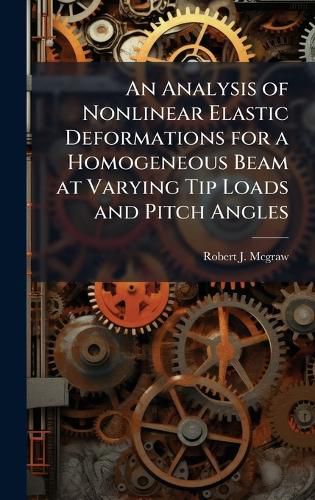Readings Newsletter
Become a Readings Member to make your shopping experience even easier.
Sign in or sign up for free!
You’re not far away from qualifying for FREE standard shipping within Australia
You’ve qualified for FREE standard shipping within Australia
The cart is loading…






The Princeton beam experiments of 1975 were performed in hopes of producing viable data for beam nonlinear elastic deformation models in hopes of improving helicopter main beam designs. The recorded data, specifically for homogeneous beams of 7075 aluminum, have been referenced as a baseline for the past thirty years to validate numerous computer models and theories in an effort to build beams capable of withstanding aeroelastic, static, and dynamic loading. The purpose of this study is to improve upon the data recorded in 1975 using newer technologies including a laser distance meter, digital inclinometer, and threedimensional traverse to test X-axis, Y-axis, Z-axis and angular displacements for varying tip loads and pitch angles.
This work has been selected by scholars as being culturally important, and is part of the knowledge base of civilization as we know it. This work was reproduced from the original artifact, and remains as true to the original work as possible. Therefore, you will see the original copyright references, library stamps (as most of these works have been housed in our most important libraries around the world), and other notations in the work.
This work is in the public domain in the United States of America, and possibly other nations. Within the United States, you may freely copy and distribute this work, as no entity (individual or corporate) has a copyright on the body of the work.
As a reproduction of a historical artifact, this work may contain missing or blurred pages, poor pictures, errant marks, etc. Scholars believe, and we concur, that this work is important enough to be preserved, reproduced, and made generally available to the public. We appreciate your support of the preservation process, and thank you for being an important part of keeping this knowledge alive and relevant.
$9.00 standard shipping within Australia
FREE standard shipping within Australia for orders over $100.00
Express & International shipping calculated at checkout
Stock availability can be subject to change without notice. We recommend calling the shop or contacting our online team to check availability of low stock items. Please see our Shopping Online page for more details.
The Princeton beam experiments of 1975 were performed in hopes of producing viable data for beam nonlinear elastic deformation models in hopes of improving helicopter main beam designs. The recorded data, specifically for homogeneous beams of 7075 aluminum, have been referenced as a baseline for the past thirty years to validate numerous computer models and theories in an effort to build beams capable of withstanding aeroelastic, static, and dynamic loading. The purpose of this study is to improve upon the data recorded in 1975 using newer technologies including a laser distance meter, digital inclinometer, and threedimensional traverse to test X-axis, Y-axis, Z-axis and angular displacements for varying tip loads and pitch angles.
This work has been selected by scholars as being culturally important, and is part of the knowledge base of civilization as we know it. This work was reproduced from the original artifact, and remains as true to the original work as possible. Therefore, you will see the original copyright references, library stamps (as most of these works have been housed in our most important libraries around the world), and other notations in the work.
This work is in the public domain in the United States of America, and possibly other nations. Within the United States, you may freely copy and distribute this work, as no entity (individual or corporate) has a copyright on the body of the work.
As a reproduction of a historical artifact, this work may contain missing or blurred pages, poor pictures, errant marks, etc. Scholars believe, and we concur, that this work is important enough to be preserved, reproduced, and made generally available to the public. We appreciate your support of the preservation process, and thank you for being an important part of keeping this knowledge alive and relevant.